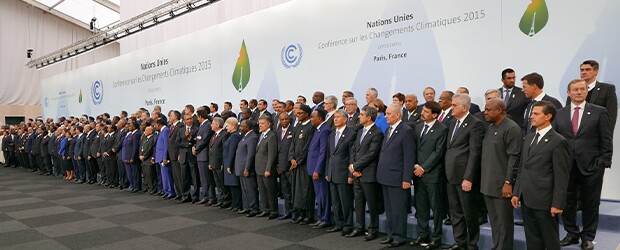In the scientific and popular lexicon, “climate change” can be traced back to a 1975 paper by geochemist Wallace Broecker and a 1979 report by the National Academy of Science. These two papers paired the term with another that would rise in prominence throughout the 1980s and 1990s, “global warming,” to alternately discuss a holistic set of changes that may occur alongside a rise in carbon dioxide in the atmosphere and the surface-level increase in temperature that was being observed and projected at the time.1
Since the 1970s, an increasingly complex legal apparatus has grown to keep pace with our understanding of the realities of global climate change. For an overview of this vital area of debate, regulation and legislative action, take a look at these 10 significant moments in the evolution of climate change law. Every professional working in the field of environmental law should be familiar with both these landmark legislative achievements of the past and the forward-looking regulations being put in place today to help avoid climate catastrophe and preserve a livable planet for future generations.
First Steps: The Clean Air Act
While not written explicitly with climate change in mind, the 1963 Clean Air Act has proved a flexible law that has seen its powers expanded several times to allow it to cover pollution in addition to that which directly impacts people’s health. It was drafted with general authorities to address pollution challenges that would emerge over time after its passing, which enabled it to be adapted to regulate climate-altering emissions. In particular, 1970, 1977 and 1990 amendments to the act have expanded its regulating authority and positioned it as a key policy in the fight against climate change.2
Renewable Energy Legislation
One of the most important ways in which climate change can potentially be curtailed is through the adoption of renewable energy sources to replace conventional fossil fuels. The promotion of renewable energy has been a topic of debate in the U.S. congress for decades, dating back at least as far as 1992, when the Senate adopted the U.N. Framework Convention on Climate change and a renewable energy production tax credit was included in the Energy Policy Act. This tax credit has been periodically extended, and an investment tax credit for solar energy installations was included 13 years later in the 2005 Energy Policy Act.3
Protracted Debate over the Kyoto Protocol
The 1997 Kyoto Protocol was a pivotal moment in global climate change regulation, as it marked the first time the world’s leading carbon-producing nations gathered together to devise a collective strategy. While the Clinton administration successfully agreed to a plan for capping and trading carbon emissions, the treaty was met with stark resistance in congress back home. Efforts to gain legislative approval of the treaty stalled in subsequent years without stipulations included that would require developing nations to follow the same guidelines as the initial signatories.4 The entire saga proved a lesson about the importance of the executive and legislative branches working together to create actionable climate change policy.
The Greenhouse Gas Reporting Program
Created as part of an appropriations bill in 2007, the Greenhouse Gas Reporting Program mandates reporting of greenhouse gas data and related information from large producers of emissions, fuel and industrial gas suppliers, and other related organizations and institutions in the U.S. While it does not have any sort of enforcement mechanism attached to it, the program supports the maintenance of a publicly available database that can be used to pressure highly polluting corporations and inform state- and local-level regulations.5
National Flood Insurance Program Responds to Climate Change
While the National Flood Insurance Program dates back to the 1968 National Flood Insurance Act, it has gained importance in recent years as catastrophic weather events and rising waters as a result of climate change have increasingly threatened coastal areas. The program is the primary source of flood insurance for residential properties in the U.S., and it has been extended multiple times since 2012. However, it is set to expire in September 2021 without action from congress, setting the stage for a crucial climate change policy debate with immediate potential impact.6
The Paris Climate Agreement: An Ongoing Saga
The U.S. was one of nearly 200 nations to sign the Paris Climate Agreement in or after 2016, pledging to limit carbon emissions in an attempt to keep global warming limited to under 2 degrees Celsius compared to pre-industrial average temperatures. But this major action at the tail end of the Obama administration was immediately reversed by the Trump administration, with an initial pledge to withdraw from the deal in 2017 followed by formal withdrawal in 2019. In early 2021, President Joe Biden reversed course once again immediately after taking office, rejoining the agreement as one of the first major acts of his administration.7 As one of the leading carbon producers in the world, the U.S.’s participation in the agreement has a significant impact on its potential success or failure.
Climate Change Policy in the December 2020 COVID Relief Bill
At the end of a year ravaged by a global pandemic, congress passed an omnibus bill predominantly intended to offer relief to businesses and communities impacted by the virus but containing a number of other unrelated provisions. Several of these latter elements combine to form a quite significant climate change policy doctrine, including formal limitations on the production of HFC refrigerants, a new directive for the Department of Energy to promote funding for renewable energy and modernization of energy infrastructures and storage systems to promote increased efficiency.8
Climate Change in President Biden’s Infrastructure Plan
The Biden Administration appears serious about legislatively dealing with the realities of climate change, seeking to write into law significant provisions to curtail greenhouse gas emissions as part of an ambitious $2 trillion infrastructure package. These include a measure called the American Jobs Plan which contains $174 billion earmarked for promoting the electric vehicle market, $1 billion for upgrades to the national infrastructure to avoid disastrous climate-related failures like those that occurred in Texas in 2021 and a new “Energy Efficiency and Clean Electricity Standard” that would require that a portion of electricity in the country come from zero-carbon sources like solar and wind power.9 While the proposal faces an uphill battle to make it through congress and will almost surely be modified along the way, it signals a bold step toward addressing the ongoing crisis through every available avenue.
State-Level Climate Change Policy
Because the Trump administration largely pursued a path of deregulation regarding climate change initiatives, the onus to pass meaningful climate policy largely fell on states over the past several years. By 2020, 12 states had committed to pursue 100% clean energy policies, joined by municipal and local governments in many more states. Other examples of recent state-level policy include the Virginia Clean Economy Act, which provides money for energy efficiency upgrades for low-income communities, the 2019 New York Climate Leadership and Community Protection Act, which requires net-zero statewide carbon emissions by 2050 and ensures that future state policies will not burden environmental justice communities, and discounts or financial incentives for farmers in Iowa and Nebraska who maintain cover crop practices to offset carbon emissions and promote healthier soil.10
A Model for Future Climate Change Law in New Zealand
In April 2021, New Zealand became the first nation to introduce climate change laws pertaining to financial firms rather than industrial firms or other actual polluters. This law requires banks, insurers and investment managers to monitor and report the impacts their businesses have on carbon emissions and climate change.11 It is a bold step toward a wider reaching climate policy that will hold all responsible parties accountable for climate-impacting activity, and one that could be replicated across the globe in the coming years.
Keep Up With the Latest in Climate Change Policy at Tulane Law School
If you work in an environmentally regulated industry, an NGO or another organization engaged with environmental policy, the Online Master of Jurisprudence in Environmental Law from Tulane University Law School can prepare you to thrive in your current role or pivot toward a new challenge. Explore the versatile curriculum of core and elective courses you could experience in this flexible online program and learn more about how Tulane’s unique online learning experience keeps you involved and helps you build your professional network.
- Retrieved on April 19. 2021 from nasa.gov/topics/earth/features/climate_by_any_other_name.html
- Retrieved on April 19, 2021 from epa.gov/sites/production/files/2015-05/documents/caa_nutshell.pdf
- Retrieved on April 19, 2021 from c2es.org/content/congress-climate-history/
- Retrieved on April 19, 2021 from fivethirtyeight.com/features/a-lesson-from-kyotos-failure-dont-let-congress-touch-a-climate-deal/
- Retrieved on April 19, 2021 from epa.gov/ghgreporting/learn-about-greenhouse-gas-reporting-program-ghgrp
- Retrieved on April 19, 2021 from fas.org/sgp/crs/homesec/IN10835.pdf
- Retrieved on April 19, 2021 from npr.org/2021/02/19/969387323/u-s-officially-rejoins-paris-agreement-on-climate-change
- Retrieved on April 19, 2021 from arstechnica.com/science/2020/12/heres-the-energy-and-environment-policy-passed-with-the-relief-bill/
- Retrieved on April 19, 2021 from cnbc.com/2021/03/31/biden-infrastructure-plan-spending-on-climate-change-clean-energy.html
- Retrieved on April 19, 2021 from americanprogress.org/issues/green/reports/2020/04/30/484163/states-laying-road-map-climate-leadership/
- Retrieved on April 19, 2021 from reuters.com/business/sustainable-business/new-zealand-introduces-climate-change-law-financial-firms-world-first-2021-04-12/


